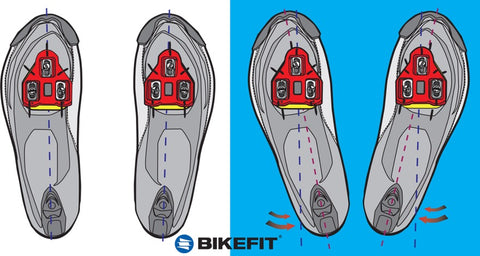
Over the years in countless bike shops, I’ve heard the following disturbing phrases uttered to cyclists: “Get these cleats. You don’t have anything to worry about.” “These cleats have float you won’t need a bike fit.” “Get these cleats with float and they’ll take care of everything.” Unfortunately, phrases and versions of these sometimes false reassuring comments are shared in not only bike shops but in forums, local rides and social media groups. Consequently, it’s time to set the record straight and dive deep into the cleat adjustment handbook. Today we’re going to tackle the following:
- Define cleat rotation and float
- Review popular cleat float types and limits
- Overview why both are needed and some suggestions
What is Cleat Rotation?
Cleat rotation is the physical movement of the cleat either clockwise or counter-clockwise to allow the foot to rotate in alignment with its natural orientation. Basically, allow the foot to point in the direction it would like to point. Generally speaking, the rotation of the cleat is similar on and off the bike. For many professional bike fitters, an off-the-bike assessment can provide an indication of the rotation required. For example, if you naturally walk with your toes out, you’ll likely require a similar setup on the bike.



What is Cleat Float?
Cleat float or pedal float is when the cleat rotates freely inward or outward while clipped into the pedal. The movement is categorized in different cleats by a number of degrees. For some companies like Shimano and Look, you can purchase cleats with varying levels of float or “fixed” cleats which meaning they are devoid of float. Float allows a person who toes in or out move the foot to a more natural position during the pedal stroke. Yet, float doesn’t necessarily solve all issues or allow enough range to meet the specific needs of an individual. More on that to come!
Sam Richardson, Level 2 BikeFit Pro Fitter, from Bicycles NYC describes Shimano cleat float levels below:
Sam expresses some significant warnings about less float requiring a bike fitting. While more float is safer because it allows increased space for the foot to function in a natural position and also may forgive cleat placement of a slightly less accurate rotation adjustment, float does replace a full bike fit (using the 5 main adjustments of the foot/pedal interface). An interesting note is the amount of float may be somewhat deceiving. Below is a diagram noting the specifics of Shimano float.

Image created by bike fitter Chad McNeese of The Spoke Shop in Billings, MT




Why is Cleat Rotation Important if Cleat Float exists?
Yes, I’ve been alluding to this throughout the article so here’s the point. As I pointed out in the video, just because there’s lateral float, does not mean a person won’t still experience pain or issues. If a cleat is not properly rotated, then it’s possible that the float will not allow enough foot rotation to achieve optimal foot position. For example, if you are a natural toe-out walker and your cleats are rotated inward, float alone is unlikely to solve the issue (especially with 3-hole and 2-hole cleats).

If this is the case, you’ll likely experience knee pain while riding most likely on the inside of the knee but more toward the back (see image). In order to avoid this pain, BikeFit professionals are trained in the process of examining the cleat from a rear position and testing rotation to find the best rotational position. While this process is outlined more specifically in our BikeFit manual and courses, it’s imperative to recognize that float and rotation both need to be taken into account during proper cleat setup and alignment. If you’re curious about the process that trained foot/pedal professionals use to assess proper cleat rotation, here are a few pictures of fitters performing the task.


Interested in expanding your knowledge? Bike retailers and shop employees with a QBP account have access to educational resources within the U of Q Training Library. Get started now.
